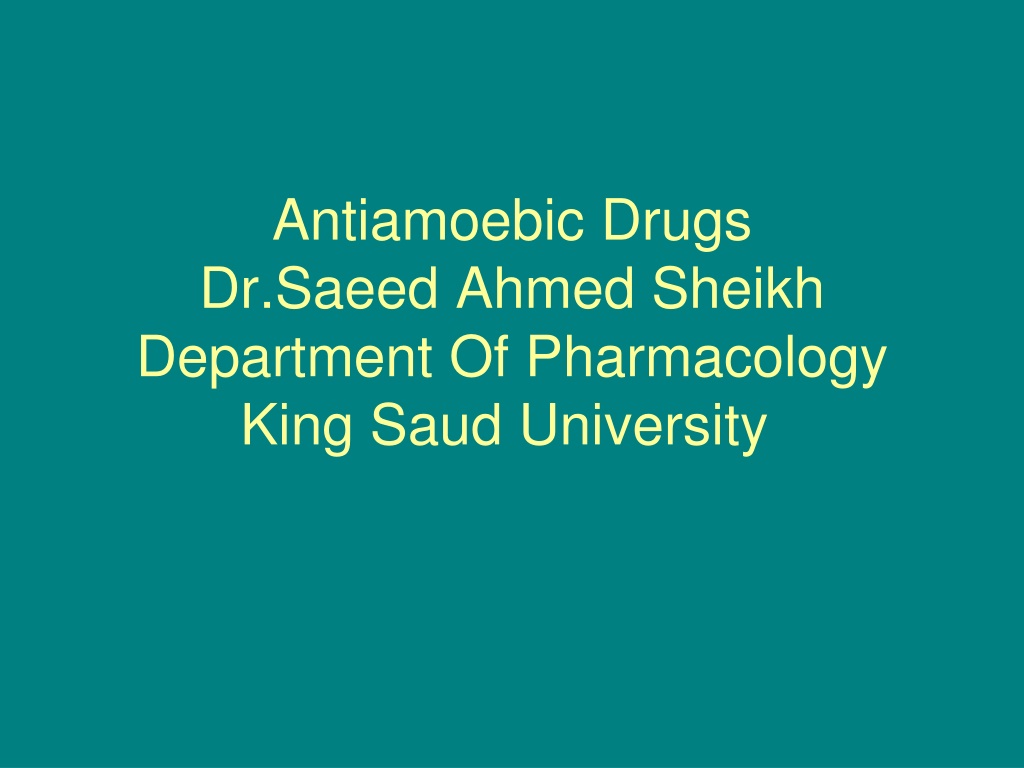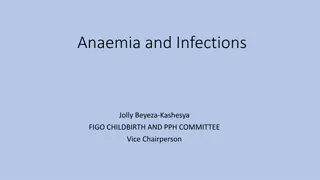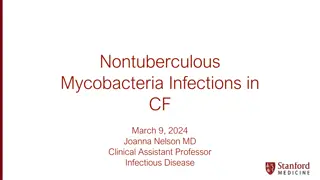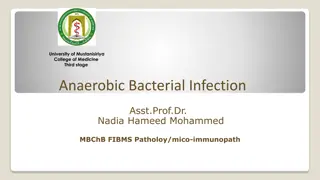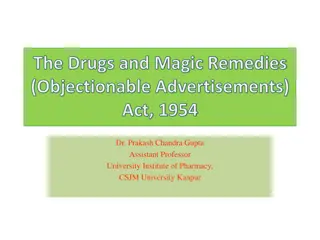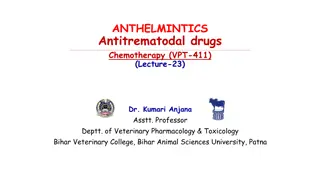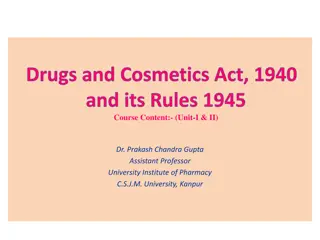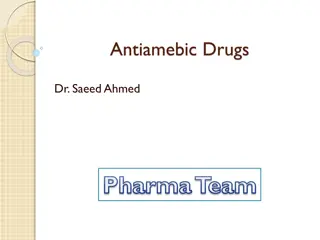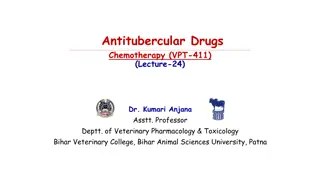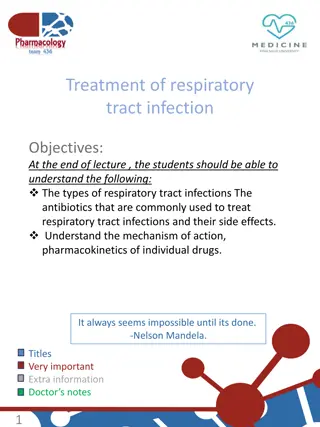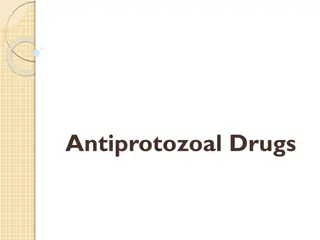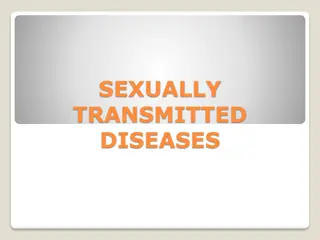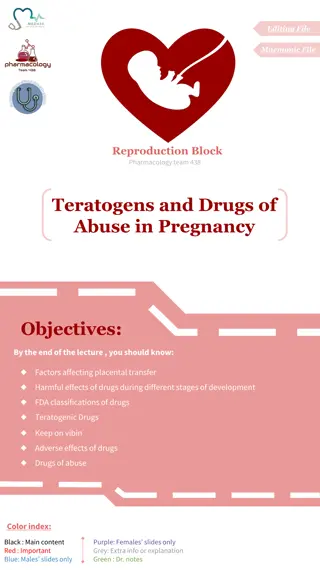Antiamoebic Drugs and Protozoal Infections
Protozoal infections such as amoebiasis, giardiasis, and malaria are a global concern, particularly prevalent in underdeveloped regions. Antiamoebic drugs serve as the primary treatment, targeting protozoal parasites like Entamoeba histolytica. However, these drugs can pose challenges due to potential toxic effects and limited safety for pregnant women. Diagnosis of amoebiasis involves isolating E. histolytica from feces. Stay informed about the complexities of treating protozoal diseases with antiamoebic medications.
Download Presentation

Please find below an Image/Link to download the presentation.
The content on the website is provided AS IS for your information and personal use only. It may not be sold, licensed, or shared on other websites without obtaining consent from the author.If you encounter any issues during the download, it is possible that the publisher has removed the file from their server.
You are allowed to download the files provided on this website for personal or commercial use, subject to the condition that they are used lawfully. All files are the property of their respective owners.
The content on the website is provided AS IS for your information and personal use only. It may not be sold, licensed, or shared on other websites without obtaining consent from the author.
E N D
Presentation Transcript
Antiamoebic Drugs Dr.Saeed Ahmed Sheikh Department Of Pharmacology King Saud University
Antiamoebic Drugs Protozoal infections are common among people in underdeveloped tropical and subtropical countries, where sanitary conditions, hygienic practices, and control of the vectors of transmission are inadequate. However, with increased world travel, protozoal diseases, such as
Antiamoebic Drugs amebiasis, giardiasis, trichomoniasis malaria, leishmaniasis, trypanosomiasis, are no longer confined to specific geographic locales. Protozoa are eukaryotes, the unicellular protozoal cells have metabolic processes closer to those of the human host than to prokaryotic bacterial pathogens.
Antiamoebic Drugs Protozoal diseases are thus less easily treated than bacterial infections, and many of the antiprotozoal drugs cause serious toxic effects in the host, particularly on cells showing high metabolic activity, such as neuronal, renal tubular, intestinal, and bone marrow stem cells.
Antiamoebic Drugs Most antiprotozoal agents have not proved to be safe for pregnant women. Antiamoebic drugs are as under: 1. Metronidazole 2. Tinidazole 3. Diloxanide furoate 4. Iodoquinol 5. Emetine and dehydroemetine 6. Chloroquine., 7. Paromomycin
Antiamoebic Drugs Amoebiasis: (It is also called amoebic dysentery) is an infection of the intestinal tract caused by Entamoeba histolytica. The disease can be acute or chronic, with patients showing varying degrees of illness, from no symptoms to mild diarrhoea to fulminating dysentery.
Antiamoebic Drugs The diagnosis is established by isolating E. histolytica from fresh faeces. Life cycle of E.histolytica: Entamoeba histolytica exists in two forms: cysts that can survive outside the body, and labile but invasive trophozoites that do not persist outside the body.
Antiamoebic Drugs Cysts, ingested through feces contaminated food or water, pass into the lumen of the intestine, where the trophozoites are liberated. The trophozoites multiply, and they either invade and ulcerate the mucosa of the large intestine or simply feed on intestinal bacteria.
Antiamoebic Drugs (one strategy for treating luminal amebiasis is to add antibiotics, such as tetracyclines to the treatment regimen, resulting in a reduction in intestinal flora the amoeba s major food source). The trophozoites within the intestine are slowly carried toward the rectum, where they return to the cyst form and are excreted in feces.
Antiamoebic Drugs Large numbers of trophozoites within the colon wall can also lead to systemic invasion. Classification of Antiamoebic Drugs: 1. systemic: Tinidazole, Chloroquine, dehydroemetine, emetine. They are effective against amebas in the intestinal wall and liver.
Antiamoebic Drugs Luminal: Diloxanide furoate, iodoquinol, paromomycin. They act on the parasites in the lumen of the bowel. Mixed: (luminal and systemic) Metronidazole
Antiamoebic Drugs Amebiasis is infection with Entamoeba histolytica. This organism can cause; 1. Asymtomatic intestinal infection 2. Mild to moderate colitis 3.Severe intestinal infection (dysentery) 4.Amoeboma 5. Liver abscess 6. Other intestinal infections
Antiamoebic Drugs Metronidazole: A nitroimidazole, is the drug of choice in the treatment of extra luminal amoebiasis. It kills trophozoites but not cysts of E.histolytica and effectively eradicates intestinal and extra intestinal tissue infections.
Antiamoebic Drugs Pharmacokinetics: Route of administration: oral, and I.V. Oral metronidazole readily absorbed and permeate all tissues by simple diffusion. Intracellular concentration rapidly approach extra cellular levels. Peak plasma concentration reached in 1- 3 hours.
Antiamoebic Drugs Protein binding is low (10-20%) The half life of unchanged drug is 7.5 hours for metronidazole Metronidazole and its metabolites are excreted mainly in the urine.
Antiamoebic Drugs Mechanism of Action: The nitro group of metronidazole is chemically reduced in anaerobic bacteria and sensitive protozoans. Reactive reduction products appear to be responsible for antimicrobial activity
Antiamoebic Drugs Clinical Uses: 1.Amoebiasis: Metronidazole is the drug of choice in the treatment of all tissue infections with E.histolytica. It is not reliably effective against luminal parasites and so must be used with a luminal amebicide to ensure eradication of the infection. Dose:750mgTDS or 500mg I.V QID1odays
Antiamoebic Drugs 2. Giardiasis: Metronidazole is the treatment of choice for giardiasis. The dosage for giardiasis is much lower and the drug thus better tolerated than that for amebiasis. 3. Trichomoniasis: Metronidazole is the treatment of choice. 2G,single dose is effective.
Antiamoebic Drugs 4. Anaerobic Bacterial infections: Metronidazole also useful in infections caused by anaerobic bacteria for e.g. bacteroids fragilis, fusobacterium, clostridium perfringens. 5. Dracunculosis: infection caused by guinea worm.
Antiamoebic Drugs Adverse effects: Nausea, dry mouth, metallic taste in the mouth and headache occurs commonly. Infrequent adverse effects include: Vomiting, Diarrhoea, insomnia, weakness, dizziness, thrush, dysuria, dark urine , paraesthesias, neutropenia, pancreatitis, ataxia, encephalopathy, seizures are rare
Antiamoebic Drugs I.V. infusion rarely caused seizures or peripheral neuropathy. CAUTION: THE DRUG SHOULD BE USED WITH CAUTION IN PATIENTS WITH CNS DISEASE. IT SHOULD BE AVOIDED IN PREGNANT WOMEN DUE TO RISK OF TERATOGENICITY(NOT PROVED IN HUMANS, PROVED IN BACTRERIA, MICE)
Antiamoebic Drugs DRUG INTERACTION: Metronidazole has a disulfiram like effect, so that nausea and vomiting can occur if alcohol ingested during therapy. It potentiate the anticoagulant effect of coumarin type of anticoagulants. Phenytoin & phenobarbitone may increase elimination of the drug, cimetidine decrease plasma clearance
Tinidazole Tinidazole, a related nitroimidazole, having similar activity and a better toxicity profile than metronidazole, and it offers simpler dosing regimens. Pharmacokinetics: Tinidazole readily absorbed and permeate all tissues by simpler diffusion.
Tinidazole Intracellular concentration rapidly approach extra cellular levels. Peak plasma level reached in 1- 3 hours. Protein binding is low(10- 20%) The half life of Tinidazole is 12- 14 hours Mechanism of Action: It has similar to metronidazole.
Tinidazole Clinical uses: 1. Amebiasis: Tinidazole is also a drug of choice in the treatment of all tissue infections with E. histolytica. It must be used with luminal amebicide because it is not effective against luminal parasites. Dose: 2 G daily for 3 days
Tinidazole 2. Giardiasis: Tinidazole is at least equally effective like metronidazole 3. Trichomoniasis: It may be effective against some of these resistant organisms Adverse effects: toxicity profile is better than metronidazole.
Diloxanide furoate Diloxanide furoate is a dichloroacetamide derivative. It is an effective luminal amebicide but is not active against tissue trophozoites. Dose: 500mg three times/day for 10 days Pharmacokinetics: After oral administration, in the gut, diloxanide furoate is split into diloxanide and furoic acid; about 90% of the drug is
Diloxanide furoate Rapidly absorbed ad then conjugated to form glucuronide, which is promptly excreted in the urine. The unabsorbed diloxanide is the active antiamoebic substance. Mechanism of Action: unknown
Diloxanide furoate Clinical uses: It is considered the drug of choice for asymptomatic luminal infections It is used with a tissue amebicide, usually metronidazole to treat serious intestinal and extra intestinal infections. Adverse effects: flatulence is common, nausea, abdominal cramps and rashes
Iodoquinol Iodoquinol (diiodohydroxyquin) is a halogenated hydroxyquinoline. Dose: 650mg TDS for 21days Pharmacokinetics: It is poorly understood 90% of the drug is retained in the intestine and excreted in feces. The remainder enters the circulation, and is excreted in the urine as glucuronides.
Iodoquinol mechanism of action: The mechanism of action of iodoquinol against trophozoites is unknown. It is effective against organisms in the bowel lumen but not against trophozoites in the intestinal wall or extra intestinal tissues Adverse effects: Diarrhoea, anorexia, nausea, vomiting, abdominal pain,
Iodoquinol Headache, rash, pruritus Neurotoxicity with prolonged use with high dosage. Cautions: 1. iodoquinol should be taken with meals to limit GI toxicity 2. it should be used with caution in patients with optic neuropathy, renal or thyroid disease, or non amebic hepatic dis.
Iodoquinol 3. The drug may increase protein-bound serum iodine, leading to a decrease in measured 131I uptake that persist for months. 4. It should be discontinued if it produces persistent diarrhea or signs of iodine toxicity( dermatitis, urticaria pruritus, fever) C.I: It is contraindicated in patients with intolerance to iodine.
Emetine and Dehydroemetine Emetine, an alkaloid derived from ipecac and dehydroemetine, a synthetic analog, are effective against tissue trophozoites of E. histolytica, but because of major toxicity concerns they have been almost completely replaced by metronidazole. Route of administration: Subcutaneous (preferred) or I.M, never I.V
Emetine and Dehydroemetine CLINICAL USES: Their use is limited to unusual circumstances. in which severe amebiasis warrants effective therapy and metronidazole can not be used. Dehydroemetine is preferred because of its some what better toxicity profile. It should be used for the minimum period usually 3- 5 days.
Emetine and Dehydroemetine Adverse effects: diarrhea is common Nausea, vomiting, muscle weakness Cardiac arrhythmias, heart failure, hypotension (serious toxicity) Caution: the drug should not be used in patients with cardiac or renal disease, in young children, or in pregnancy.
Paromomycin Paromomycin is an aminoglycoside antibiotic. It is not significantly absorbed from the GIT. The small amount absorbed, is slowly excreted unchanged, mainly by glomerular filtration. Dose: 10mg/kg TDS for 7 days
Paromomycin Clinical uses: It is used only as a luminal amebicide, has no effect against extra intestinal amebic infections. Paromomycin is an effective luminal amebicide that appears to have similar efficacy and less toxicity than other agents.
Paromomycin In a recent study, it was superior to diloxanide furoate in clearing asymptomatic infections. Parenteral paromomycin is under investigation in treatment of visceral leishmaniasis. Adverse effects: abdominal distress, diarrhea. It should be avoided in patients with significant renal disease and cautiously used with G I ulceration
Tetracyclines Tetracyclines are broad spectrum bacteriostatic that inhibit protein synthesis in susceptible microorganisms. They are active against many gram- positive and gram- negative bacteria including anaerobes, rickettsiae, chlamydiae, mycoplasma, and against some protozoa e.g., amebas.
Tetracyclines Mechanism of action: Tetracyclines enter microorganisms in part by passive diffusion and in part by an energy dependent process of active transport. Susceptible cells concentrate the drug intracellularly. Once inside the cell, tetracyclines bind reversibly to the 30S subunit of the bacterial ribosimes, blocking the binding of aminoacyl- tRNA to the acceptor site on the mRNA- ribosome complex. This prevents addition of aminoacid to the growing peptide . .
Tetracyclines Dose: 250mg 3 times daily for 10 days Adverse effects: 1. G I adverse effects: nausea, vomiting,diarrhea 2. bony structure and teeth 3. liver toxicity 4. kidney toxicity 5.photosensitization 6.vestibular reactions
Erythromycin Erythromycin 500mg, 4 times daily for 10 days. Erythromycin inhibits protein synthesis occurs via binding to the 50S ribosomal RNA, which blocks the aminoacyl translocation reaction and formation of initiation complexes.
Chloroquine It is used in combination with metronidazole and diloxanide furoate to treat and prevent amoebic liver abscesses. It eliminates trophozoites in liver abscesses, but it is not useful in treating luminal amebiasis
Chloroquine MECHANISM OF ACTION: Chloroquine probably acts by concentrating in parasitic food vacuoles, preventing the polymerization of the hemoglobin breakdown product, heme into hemozoin, and thus eliciting parasite toxicity due to buildup of free heme.
Chloroquine Adverse effects: pruritus is common, nausea, vomiting, abdominal pain, anorexia. Headache, blurring of vision uncommon. Hemolysis in G6-PD deficient patients, impaired hearing, agranulocytosis alopecia, hypotension.
